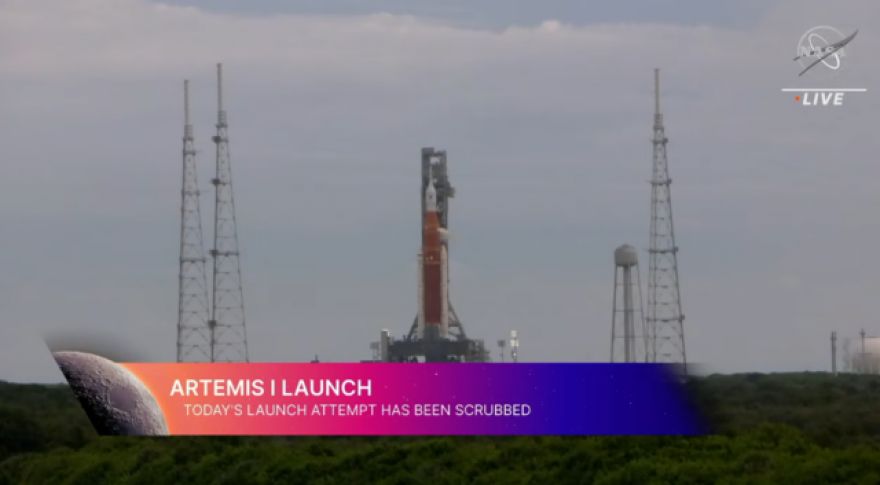
NASA Artemis Launch Scrubbed After ‘Engine Bleed’ Issue
Artemis 1 is a test flight, a vanguard of NASA’s Artemis mission to put boots on lunar soil within the 2020s. The rocket was scheduled to lift off at 8:33 AM EDT (12:33 GMT) from Pad 39B at NASA’s Kennedy Space Center. However, mission controllers scrubbed the Artemis launch at T-40 minutes.
Safety checks before launch halted the countdown. “The launch director called a scrub because of an engine bleed that couldn’t be stopped,” Artemis launch control explained. “Engineers are gathering data about this engine and the bleed that didn’t work out. The hydrogen bleed was a goal of the previous wet dress rehearsal that didn’t happen due to a hydrogen leak, so engineers are focused on gathering as much data as they can.
Because the SLS didn’t take off, NASA will now use one of the mission’s backup launch dates: this Friday, Sept. 2 at 12:48 PM EDT, or perhaps next Monday, Sept. 5. At the time of publication, the agency hasn’t given a new launch date.
“We don’t launch until it’s right,” NASA administrator Bill Nelson said in a briefing after the scrub. “They’ve got a problem with the gases going on the engine bleed on one engine. You can’t go. There are certain guidelines. And I think it’s just illustrative that this is a very complicated machine, a very complicated system, and all those things have to work. You don’t want to light the candle until it’s ready to go.”
Stress Test
On Saturday, NASA detected five lightning strikes at Pad 39B, but the agency is confident that none of the strikes affected the SLS rocket itself. Instead, all five hit the launchpad’s lightning protection system — a system of towers and ‘catenary wires’ that can divert and safely ground out lightning strikes. NASA Artemis 1 senior test director Jeff Spaulding said none of the strikes represented a threat to the launch in a Sunday briefing.
Once in lunar orbit, the Orion capsule will remain in lunar orbit for 42 days. That’s twice as long as it will orbit with humans on board. It is a stress test, and NASA officials remain circumspect.
“In all of our excitement, I want to remind people this is a test flight,” NASA Administrator Bill Nelson . “We’re going to stress this thing in a way that we would never do with humans on board. And so I just want to bring everybody back to reality.”
Clocking in at 8.8 million pounds of thrust, the SLS rocket is more powerful than NASA’s Saturn V super-heavy lift vehicle. Atop the rocket sits the Orion space capsule, fully 30 percent larger than its Apollo ancestor.
Instead of human passengers, for Artemis 1 the Orion capsule is carrying three crash test dummies rocket scientists. Two are female mannequin torsos, named Helga and Zohar. Most crash test dummies are male-bodied, so most safety gear is sized for men. Unfortunately, that means that women are disproportionately likely to be injured during a crash or accident. Helga and Zohar are testing out safety gear and a shiny new radiation protection vest, all sized for women. The third is a mannequin named Commander Moonikin Campos, who will helm the mission.
NASA’s SLS: Launching Real Soon Now
NASA’s Space Launch System is sometimes “affectionately” called the Senate Launch System. That’s because the SLS is also a de facto jobs program, bringing tens of thousands of solid jobs to “space states,” mostly in Alabama. But in light of the SLS’s ever-expanding cost, along with the current and future launch capabilities of private space companies like Blue Origin, RocketLab, and SpaceX — why does the SLS program still exist at all?
NASA’s Artemis I mission is the first integrated test of the agency’s deep space exploration systems: the Orion spacecraft, SLS rocket, and supporting ground systems. Image credit: NASA/Joel Kowsky
Earlier this year, Paul Martin, NASA’s inspector general, spoke before Congress. Martin said that his office had calculated the cost for the first three flights of the SLS to be $4.1 billion each — a price tag the inspector general said was “unsustainable.” NASA and Boeing both pushed back on that analysis, on grounds that it included a long list of unrelated expenses. But an independent analyst calculated that the SLS would cost between $876 million and $2 billion per launch, depending on how one tallies up the total.
Put bluntly, these are all huge numbers. Meanwhile, SpaceX can put a Falcon Heavy rocket in low-earth orbit for around $100 million per launch. And at the same time, NASA’s whole goal is to be “one of many” entities with a presence in LEO and, eventually, lunar orbit. The agency’s Commercial Crew and Commercial Cargo programs are attempts to ensure that SpaceX and other private launch companies create a robust commercial ecosystem in space. In Martin’s words, “relying on such an expensive, single-use rocket system will, in our judgment, inhibit if not derail NASA’s ability to sustain its long-term human exploration goals to the moon and Mars.”
According to a NASA review, the SLS supports about 25,000 jobs nationwide, with a total economic impact of $4.7 billion.